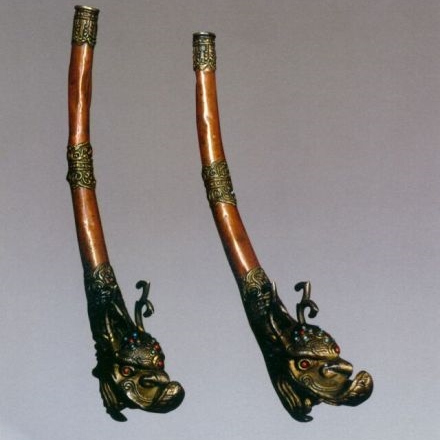Gangdong overview

Gangdong (pinyin: Gangdong), derived from ancient horn-like musical instruments, is a Tibetan, Mongolian, and Han lip-vibrating gas-singing musical instrument. One of the Buddhist instruments. The tube body is mostly made of copper, but also made of silver or bone, and its size varies. Popular in Tibet, Inner Mongolia, Qinghai, Sichuan, Yunnan, Gansu, Hebei and other provinces.
Gangdong has no fixed pitch, and its music has the meaning of calling the gods. It is mainly used for chanting music in Lama monasteries, Qiangmu performances and religious ceremonies. It is a religious musical instrument commonly used in large-scale Tibetan Buddhist monasteries. In Baoding, Xushui, Dingxian, Laishui and other places in Hebei Province, copper steel holes are also used, which are used in the performance of "Southern Music Club", and are locally called Lamahao or "Haizhuzi".
When playing, hold the upper end of the pipe body vertically with the left or right hand, and the air flow enters from the mouthpiece to produce sound. The copper-made steel hole has a humming sound, a rough tone, and a very loud volume. Two wind instruments are often used at the same time, first in turn, and then together in an ensemble.- type:lip vibration instrument
- popular area:Tibet, Inner Mongolia, Qinghai, Sichuan, Yunnan, Gansu, Hebei and other provinces
- alias:Gangling, Zaling
overview of other similar instruments
- sanyanxiao overview
- Daguangxian overview
- Leiqin overview
- hahao overview
- yandundagu overview
- Han Xiaozheng overview
- Fang Xiang overview
- guanzi overview
- zhuqin (Dao Qin) overview
- zhuiqin overview
- bangzi overview
- three-stringed piano overview
- Gehu overview
- xiao overview
- xiaokonghou overview
- Konghou overview
- Sheng overview
- suona overview
- hulusi overview
- gushao overview
 渝公网安备 50010702504639号
渝公网安备 50010702504639号